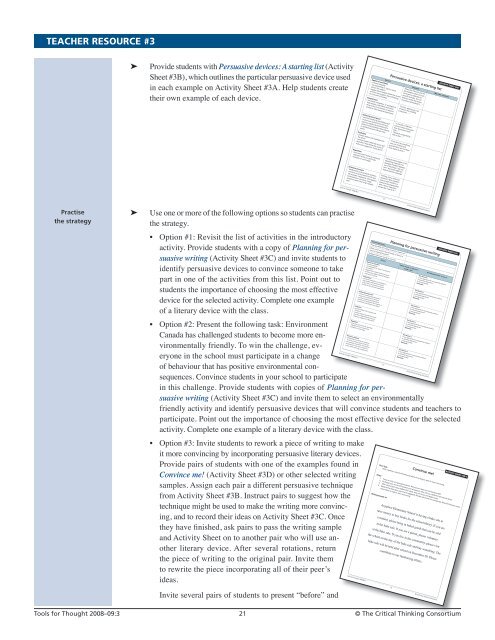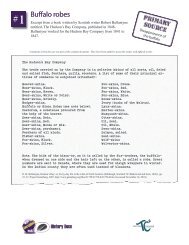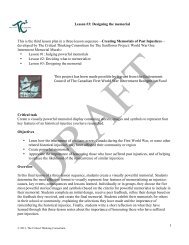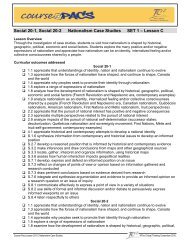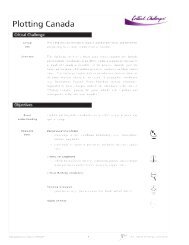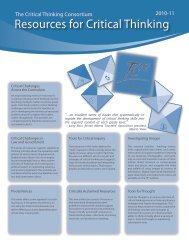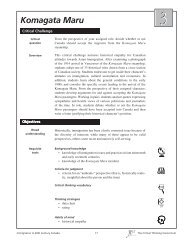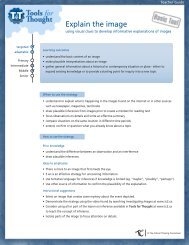Inquiry-mindedness - The Critical Thinking Consortium
Inquiry-mindedness - The Critical Thinking Consortium
Inquiry-mindedness - The Critical Thinking Consortium
Create successful ePaper yourself
Turn your PDF publications into a flip-book with our unique Google optimized e-Paper software.
– others– onesTEACHER RESOURCE #3➤➤Provide students with Persuasive devices: A starting list (ActivitySheet #3B), which outlines the particular persuasive device usedin each example on Activity Sheet #3A. Help students createtheir own example of each device.Persuasive devices: a starting listAppeal to emotions “Meet Zoe. She’s six and she– provoke empathy has leukemia. She’s not sure– use storytelling to “paint a visual she’ll get to celebrate her– picture for readers” seventh birthday. You can– suggest that if readers follow the course help her realize her dream– of action you suggest, they will belong of going to Disneyland if …”– to or be part of a groupDevice Example My own exampleACTIVITY SHEET #3BComparisons “For Zoe, walking up a set– use similes, metaphors, or analogies to of stairs is like climbing– help readers understand what some- a mountain …”– thing is like or to connect an abstract– concept to their personal experiencesAuthority/social proof “In Canada, 1,500 kids– convince readers by providing proof contract cancer every year.– of your own authority on the issue Your donations ensure– convince readers by providing facts, that …”– statistics, and quotations from experts, “Research conducted by …– or testimonials and referrals from tells us that …”Prediction “If we don’t do something– provide readers with a glimpse into now, our children and– the future grandchildren will not have– convince readers what the future will clean water to drink.”– look like if they follow the course of– action you suggest (or if they don’t)Repetition Using the same slogan on all– drive your point home by repeating advertising materials. For– important terms or a particular example, President Obama’s– metaphor or vivid image use of the phrase “Yes, weSentence structure Starting with a rhetorical– deliberately use a particular sentence question (“Who wouldn’t– structure at various points of the text want a loyal friend?”) orcan!” during the 2009 U.S.federal election campaign.– (for example, imperative, interrogative, ending a long explanation– exclamatory) or use short, simple with a short, imperative– sentences rather than long, complex phrase like “Just do it.”Tools for Thought 2008-09:3 24 © <strong>The</strong> <strong>Critical</strong> <strong>Thinking</strong> <strong>Consortium</strong>Practisethe strategy➤➤Use one or more of the following options so students can practisethe strategy.• Option #1: Revisit the list of activities in the introductoryactivity. Provide students with a copy of Planning for persuasivewriting (Activity Sheet #3C) and invite students toidentify persuasive devices to convince someone to takepart in one of the activities from this list. Point out tostudents the importance of choosing the most effectivedevice for the selected activity. Complete one exampleof a literary device with the class.• Option #2: Present the following task: EnvironmentCanada has challenged students to become more environmentallyfriendly. To win the challenge, everyonein the school must participate in a changeof behaviour that has positive environmental consequences.Convince students in your school to participatein this challenge. Provide students with copies of Planning for persuasivewriting (Activity Sheet #3C) and invite them to select an environmentallyfriendly activity and identify persuasive devices that will convince students and teachers toparticipate. Point out the importance of choosing the most effective device for the selectedactivity. Complete one example of a literary device with the class.• Option #3: Invite students to rework a piece of writing to makeit more convincing by incorporating persuasive literary devices.Provide pairs of students with one of the examples found inConvince me! (Activity Sheet #3D) or other selected writingsamples. Assign each pair a different persuasive techniquefrom Activity Sheet #3B. Instruct pairs to suggest how thetechnique might be used to make the writing more convincing,and to record their ideas on Activity Sheet #3C. Oncethey have finished, ask pairs to pass the writing sampleand Activity Sheet on to another pair who will use anotherliterary device. After several rotations, returnthe piece of writing to the original pair. Invite themto rewrite the piece incorporating all of their peer’sideas.Invite several pairs of students to present “before” andOverall planningPurpose: What am I trying to convince readers of?What action would I like the reader to take as aresult of reading this piece?Audience: Who am I trying to convince?Planning for persuasive writingDevice What words or phrases Deciding whether to use itcould I use?Appeal to emotions This device is:– provoke empathy ❏ very appropriate for my purpose & audience– use storyte ling to “paint a visual picture ❏ somewhat appropriate– fo readers” ❏ not appropriate– sugges that if readers fo low the course Rationale: ❏– of action you suggest, they wi l belong to– or be part of a groupComparisons This device is:– use similes, metaphors, or analogies to ❏ very appropriate for my purpose & audience– help readers understand what some- ❏ somewhat appropriate– thing is like or to connect an abstract ❏ not appropriate– concep to their personal experiences Rationale:Authority/social proof This device is:– convince readers by providing proof ❏ very appropriate for my purpose & audience– of your own authority on the issue ❏ somewhat appropriate– convince readers by providing facts, ❏ not appropriate– statistics, and quotations from experts, or Rationale:– testimonials and referrals from others–Prediction This device is:– provide readers with a glimpse into ❏ very appropriate for my purpose & audience– the future ❏ somewhat appropriate– convince readers wha the future wi l ❏ not appropriate– look like if they fo low the course of Rationale:– action you suggest (or if they don’t)Repetition This device is:– drive your point home by repeating ❏ very appropriate for my purpose & audience– importan terms or a particular ❏ somewhat appropriate– metaphor or vivid image ❏ not appropriateRationale:Sentence structure This device is:– deliberately use a particular sentence ❏ very appropriate for my purpose & audience– structure at various points of the text ❏ somewhat appropriate– (for example, imperative, interrogative, ❏ not appropriate– exclamatory) or use short, simple sen- Rationale:– tences rather than long, complex onesTools for Thought 2008-09:3 25 © <strong>The</strong> <strong>Critical</strong> <strong>Thinking</strong> <strong>Consortium</strong>Your Task:With a partner, rework the following piece of writing to make it more convincing.Convince me!Tools for Thought 2008-09:3 26 © <strong>The</strong> <strong>Critical</strong> <strong>Thinking</strong> <strong>Consortium</strong>ACTIVITY SHEET #3CACTIVITY SHEET #3D-1Steps:1. Focus on only one persuasive device. Record your ideas on Activity Sheet #3C.2. Exchange your work with another pair of partners who will use a different persuasive device.3. After several pairs have added their ideas, they will return the page to you.4. Read all the ideas your peers have suggested. Decide which ones to incorporate. Rewrite the piece usingthose ideas to make it more convincing.Writing Sample #1Tools for Thought 2008–09:3 21 © <strong>The</strong> <strong>Critical</strong> <strong>Thinking</strong> <strong>Consortium</strong>


